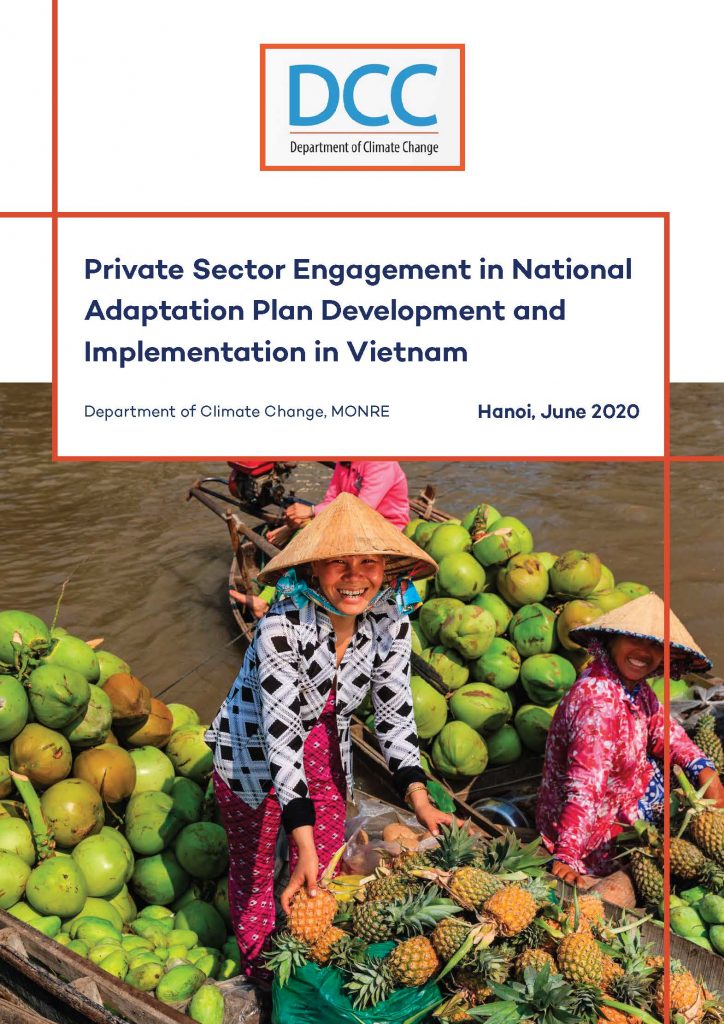According to Germanwatch’s 2019 report, Vietnam is one of the top 10 countries vulnerable to climate change. According to the World Bank, more than 60% of Vietnam’s population lives in climate risk areas, including the in rural, coastal, and mountainous regions. Over the past two decades, approximately 226 disaster and extreme weather events have occurred in Vietnam, causing an annual economic loss of about USD 2 billion per year.

Why involve the private sector?
The Government of Vietnam has always actively participated in international climate change agreements, including the Paris Agreement on climate change, the Hyogo Framework for Action, and Sendai Framework for Disaster Risk Reduction. Vietnam has also actively developed national plans and programs to implement these international commitments while enhancing the resilience of its people in the context of climate change. Despite this, the budget source from the state is insufficient to carry out the range of programs and plans needed to effectively adapt to climate change. Therefore, attracting private sector involvement in the development and implementation of the National Adaptation Plan (NAP) is paramount.
The private sector can help fund parts of the NAP implementation and develop the innovative products and services needed to increase resilience. Businesses in vulnerable sectors can strengthen resilience through the creation of new products, services, and business models to adapt to climate change. These businesses can identify challenges in their development plans, as well as take the lead in building the capacity to withstand climate change and promote sustainable development.
The research process
With the support of the NAP Global Network, Vietnam’s NAP focal point initiated and evaluated private sector engagement in adaptation. This involved carrying out research and organizing two consultation workshops to evaluate the impacts of climate change within a group of enterprises representing the high-risk sectors impacted by climate change, including agriculture, fisheries, tourism services, and small and medium-sized enterprises.
More than 70% of the interviewed enterprises had suffered from natural disaster and climate change impacts, mostly listing losses of facilities, indirect losses caused by traffic being hampered, power disconnection, and value-chain disruption. In spite of this, the involvement of the businesses seemed to focus on disaster recovery and restoration activities rather than planned adaptation. Few businesses invested in minimizing risks before disasters occur, which is the goal of sustainable, long-term adaptation activities.
The barriers to private sector participation
According to Mr. Nguyen Tuan Quang, Deputy Director of the Department of Climate Change and NAP focal point of Vietnam, it is impossible not to mention the role of the business community when planning for national adaptation. Currently, the private economy accounts for the largest proportion in Vietnam’s economic sector structure, employing 84% of the total labour force and contributing to 38% of GDP compared to the 29% contributed by the state. This shows the potential for a large contribution from the private sector, which needs to be further explored. However, there are still many barriers that restrict the development of the private sector, including climate change. In fact, businesses represent a group that is both significantly affected by climate change and that can—and should—be directly involved in adaptation and mitigation solutions to climate change.

The research results show that the biggest barriers to private sector participation in the NAP process are the existing policy and financial mechanisms. A number of policies and laws treat businesses as a group to be managed, but should treat them as viable partners for climate change adaptation. Many national programs and strategies for climate change adaptation have been developed but lack the budget for implementation. Though some programs mention the participation of enterprises, they do not provide a financial mechanism or highlight the potential investment opportunities that would make it appealing to private enterprises to implement climate change adaptation projects.
Speaking at the consultation workshop, representatives of international non-governmental organizations, banks, and businesses said that two mechanisms are necessary to promoting the participation of the private sector: an appropriate legal framework and a financial mechanism. While policies for climate change mitigation are quite well understood—including payments for environmental services, carbon credit markets, and investment in renewable energy development—and have attracted many in the private sector, this clarity does not apply to the policies and mechanisms in place for climate change adaptation. Businesses need more accessible information to understand that climate change adaptation investment is not just about mitigating climate risks—it’s about profit.
It is absolutely critical to make the business case for the private sector as to why they should engage in the NAP process. Therefore, it is necessary to develop a roadmap of engagement strategies in parallel with the implementation of the government’s commitments set out in the NAP. In addition, it is necessary to help businesses understand that the development and implementation of the NAP is both a responsibility and a right of enterprises for tax incentives, creating new business opportunities, and access to additional capital resources. The NAP implementation phase is in desperate need of a mechanism to promote the participation of banks and insurance companies.
Representatives also proposed that the relevant agencies should support the development of tools to assess the impacts of climate change and natural disasters within the private sector, as well as provide uniform regulations and guidance on the evaluation process of these impacts. At the same time, it is necessary to develop a flexible tax credit support mechanism, suitable to the type and sizes of the businesses (for example, making tax deductions according to the level of emission reduction or the level of damage due to natural disasters). It is also necessary to provide the appropriate types of disaster insurance for climate change, improve the legal framework for technology transfer, and provide training courses on climate change adaptation and disaster risk management for business representatives and business associations.

Involved in the NAP process
The National Adaptation Plan (NAP) for the period of 2021–2030, with a vision to 2050, was approved by the prime minister in July 2020. Recognizing that resources from the private sector play an important role in enhancing the capacity to adapt to the impacts of climate change at the national level, the NAP document emphasizes the following: “The State creates the legal basis and applies the economic tools to ensure the effective implementation of policies and laws on climate change adaptation, and can encourage and create the conditions for domestic and foreign financial institutions to invest and support the implementation of the NAP.”
Engaging the private sector in the NAP development stage was an important first step for government agencies to understand the challenges and opportunities to attract private investment in climate change adaptation. Some of the recommendations from the private sector that have been retained for the NAP implementation phase include public–private partnership mechanisms, business and farmer cooperation models for building climate resilience, green finance, and climate information services.
The Department of Climate Change would like to thank the International Institute for Sustainable Development (IISD) and the NAP Global Network for their continued technical assistance in developing a detailed private sector engagement strategy for the NAP process as it begins its implementation phase.